Guppy Poecilia Ret in Pairs Blue Lace Guppies (1 Male + Female), Vibrant Companions for Your Freshwater Aquarium, Explore Guppy Breeding and Nutrition Tips for Optimal Care, Stunning Color for Beginners
£25.49 Original price was: £25.49.£21.29Current price is: £21.29.
Welcome these beautiful Guppy Poecilia Ret pairs, featuring stunning blue lace patterns, into your freshwater aquarium. Ideal for aquarists seeking easy-care fish, these peaceful companions thrive in a well-maintained environment, enhancing your aquatic beauty and joy.
64 in stock
Species Introduction
The Guppy, scientifically known as Poecilia reticulata, is a small, colorful freshwater fish belonging to the family Poeciliidae. Originating from the warm, shallow waters of the Caribbean and parts of South America, these vibrant creatures are often found in streams, ponds, and marshes. Guppies are renowned for their adaptability and resilience, making them a popular choice among aquarium enthusiasts. Their lively colors and patterns, particularly the stunning blue lace variety, add a splash of beauty to any freshwater aquarium. With a maximum length of around 6 cm, they are small enough to thrive in community tanks while providing an engaging visual experience. Guppies are peaceful fish, making them ideal companions for a variety of other species in a well-maintained aquarium.
Care Requirements Dashboard
| Optimal Living Conditions | |
|---|---|
| Water Temperature | 24-27°C (75-81°F) |
| pH Level | 6.5-7.5 |
| Water Hardness | 4-12 dKH |
| Minimum Tank Size | 80L (20 gal) |
| Salinity | Freshwater |
| Care Level | Beginner Friendly |
To successfully care for your Guppy Poecilia Ret, it is crucial to provide a stable environment that mimics their natural habitat. A minimum tank size of 10 gallons is recommended to ensure ample swimming space and to maintain water quality. Guppies thrive in warm waters, with temperatures ranging between 22-28°C (72-82°F). The pH level should be kept between 6.8 and 7.8, while water hardness should ideally be between 10 and 30 dGH. Regular water changes and monitoring of these parameters will help maintain a healthy environment for your aquatic companions.
Natural Behavior & Temperament
Guppies are known for their lively and active nature. They exhibit a range of swimming patterns, often darting around the tank in search of food or exploring their surroundings. Their social behavior is quite pronounced; they thrive in groups and are best kept in schools of at least five or more. This not only enhances their natural behaviors but also reduces stress levels among the fish. Guppies are generally peaceful and can coexist with a variety of community fish, making them an excellent choice for mixed-species tanks. However, it is essential to monitor their interactions with other species to ensure compatibility and prevent any aggressive behavior.
Tank Setup Guide
Creating an ideal environment for your Guppy Poecilia Ret involves careful consideration of tank setup. Start with a spacious aquarium of at least 10 gallons, as this will provide adequate swimming space and help maintain stable water conditions. Substrate options include fine gravel or sand, which will allow for easy cleaning and maintenance. Incorporate plenty of live plants, such as Java Fern or Anubias, to create hiding spots and encourage natural behavior. Additionally, decorations like driftwood or rocks can enhance the aesthetic appeal of the tank while providing territories for the fish. Ensure that the tank is equipped with a reliable filtration system to maintain water quality and a heater to regulate temperature.
Water Quality Management
✓ Good Water Quality
pH Level: 6.8-7.8
Temperature: 22-28°C (72-82°F)
Hardness: 10-30 dGH
Maintaining optimal water quality is crucial for the health and well-being of your Guppy Poecilia Ret. Regular testing of water parameters is essential to ensure that the pH level remains between 6.8 and 7.8, as fluctuations can stress the fish. The temperature should be consistently kept within the range of 22-28°C (72-82°F) to promote healthy activity levels. Water hardness should be monitored as well, ideally maintaining levels between 10 and 30 dGH. Regular water changes, ideally 25% weekly, will help remove toxins and replenish essential minerals, contributing to a stable and healthy environment.
Feeding & Nutrition
Feeding your Guppy Poecilia Ret a balanced diet is key to their health and vibrant coloration. These fish are omnivorous, meaning they thrive on a varied diet that includes high-quality flake foods, frozen or live foods such as brine shrimp, daphnia, and bloodworms. A feeding schedule of 2-3 small meals per day is recommended to ensure they receive adequate nutrition without overfeeding. It is essential to remove any uneaten food after a few minutes to maintain water quality. Additionally, consider supplementing their diet with plant-based foods, as this can enhance their overall health and coloration. Regularly changing the types of food offered can also prevent boredom and encourage natural foraging behavior.
Compatibility Guide
✓ Peaceful Fish
Best Tank Mates: Neon Tetras, Corydoras, Platies, Swordtails
Avoid: Aggressive species like Cichlids
When selecting tank mates for your Guppy Poecilia Ret, it is essential to choose peaceful species that will not pose a threat to their well-being. Ideal companions include Neon Tetras, Corydoras, Platies, and Swordtails, all of which share similar water parameters and temperament. It is crucial to avoid aggressive species, such as Cichlids, as they can stress or harm your Guppies. When introducing new fish to the tank, always monitor their interactions closely to ensure compatibility and a harmonious environment.
Health & Wellness
Maintaining the health and wellness of your Guppy Poecilia Ret involves regular monitoring for signs of common health issues. Some of the most prevalent problems include fin rot, ich, and swim bladder disease. To prevent these issues, ensure that water quality is consistently high and that the tank is not overcrowded. Observing your fish for any behavioral changes, such as lethargy, loss of appetite, or abnormal swimming patterns, can help identify potential health concerns early. If any signs of illness are detected, it is crucial to act quickly, consulting with a knowledgeable aquarist or veterinarian for appropriate treatment options.
Breeding Information
Guppies are livebearers, meaning they give birth to free-swimming fry rather than laying eggs. To breed your Guppy Poecilia Ret successfully, it is essential to provide a suitable breeding environment. A separate breeding tank with ample hiding spots and a gentle filter is recommended to protect the fry from being eaten by adult fish. The female Guppy can give birth to 20-100 fry at a time, depending on her age and health. After birth, it is crucial to provide the fry with finely crushed flake food or specialized fry food to ensure proper growth. Monitoring the fry closely during their early days is essential to ensure their survival and health.
Acclimation Process
When introducing your Guppy Poecilia Ret to a new aquarium, proper acclimation is vital to reduce stress and ensure a smooth transition. Begin by floating the sealed bag containing the fish in the tank for about 15-20 minutes to equalize the temperature. After this, gradually mix small amounts of tank water into the bag over the next hour, allowing the fish to adjust to the new water parameters. Once acclimated, gently release the fish into the tank using a net to avoid introducing any bag water. This careful acclimation process will help your Guppies settle into their new home with minimal stress.
Long-term Care
Long-term care for your Guppy Poecilia Ret involves regular maintenance and monitoring of their environment. As these fish can live up to 2-3 years with proper care, it is essential to provide a consistent habitat that meets their needs. Regular water changes, tank cleanings, and monitoring of water parameters will help maintain a healthy environment. Additionally, observing your fish for any signs of stress or illness will allow you to address any issues promptly. Providing a varied diet and ensuring a balanced community tank will contribute to the overall health and longevity of your Guppies.
Natural Habitat Recreation
To recreate a natural habitat for your Guppy Poecilia Ret, consider incorporating elements that mimic their native environment. This can include a substrate of fine gravel or sand, along with live plants such as Java Moss or Hornwort, which provide hiding spots and a natural food source. Driftwood and rocks can also be added to create territories and enhance the aesthetic appeal of the tank. Ensuring that the tank is well-planted not only benefits the fish but also contributes to the overall health of the aquarium ecosystem by providing oxygen and absorbing nitrates.
Seasonal Care Adjustments
As seasons change, adjustments may be necessary to maintain optimal conditions for your Guppy Poecilia Ret. In the warmer months, ensure that the tank temperature does not exceed 28°C (82°F) by using fans or air conditioning if needed. Conversely, during colder months, a reliable heater is essential to maintain a stable temperature. Additionally, monitor the lighting duration, as longer days in summer may require adjustments to prevent excessive algae growth. Regularly checking water parameters during seasonal changes will help ensure a healthy environment for your aquatic companions.
Expert Tips
For those looking to enhance their experience with Guppy Poecilia Ret, consider implementing some expert tips. Regularly rotating tank decorations and plants can stimulate the fish and encourage natural behaviors. Additionally, consider breeding different color strains to create a vibrant display of Guppies in your aquarium. Keep a close eye on the male-to-female ratio, as too many males can lead to stress and aggression. Lastly, maintaining a consistent feeding schedule and providing a varied diet will ensure your Guppies remain healthy and colorful.
Troubleshooting
Should you encounter any issues with your Guppy Poecilia Ret, it is essential to address them promptly. Common problems include stress from overcrowding, poor water quality, or incompatible tank mates. If you notice signs of illness, such as lethargy or abnormal swimming, check water parameters immediately and perform a water change if necessary. If fin rot or other infections occur, consider isolating the affected fish and treating them with appropriate medications. Keeping a close eye on your fish and their environment will help you troubleshoot any potential issues effectively.
Scientific Background
The Guppy Poecilia Reticulata is a fascinating species with a rich scientific background. Belonging to the family Poeciliidae, they are part of a diverse group of fish that includes other popular species such as Mollies and Platies. Guppies have been extensively studied for their breeding habits and genetic diversity, making them a favorite among aquarists and researchers alike. Their ability to adapt to various environments and their vibrant colors have made them a staple in the aquarium trade. Conservation efforts are essential to protect their natural habitats, as urbanization and pollution threaten their populations in the wild.
Advanced Care Techniques
For experienced aquarists looking to take their care of Guppy Poecilia Ret to the next level, consider implementing advanced techniques. Utilizing a breeding box can help separate pregnant females from the main tank, ensuring fry survival. Additionally, experimenting with different food types, such as spirulina flakes or high-protein pellets, can enhance coloration and vitality. Regularly monitoring and adjusting water parameters will help maintain optimal conditions, while utilizing a quarantine tank for new arrivals can prevent the introduction of diseases. Engaging in community forums and networking with other aquarists can provide valuable insights and tips for advanced care.
Frequently Asked Questions
Q: What tank size is required for Guppy Poecilia Ret?
For Guppy Poecilia Ret, a minimum tank size of 40 litres is recommended. This size allows sufficient swimming space and helps maintain stable water parameters, which are crucial for their health and vitality. Guppies are social fish that thrive in groups, so providing adequate space not only supports their physical well-being but also encourages natural behaviours. Ideally, a larger tank can accommodate more guppies and enhance the visual appeal of your aquarium. Regular maintenance is also easier in a larger setup, as it can help buffer against fluctuations in water quality.
✓ Expert Tip
Consider adding live plants to the tank, as they not only improve water quality but also provide hiding spots for guppies, making them feel secure.
Q: What water parameters do Guppy Poecilia Ret require?
Guppy Poecilia Ret thrive in slightly alkaline water with a pH between 7.0 and 8.0. The water hardness should be around 10-20 dGH, which mimics their natural habitat. Maintaining a temperature range of 22-28°C is vital for their metabolic health. Regularly testing the water parameters helps ensure a stable environment. Ammonia and nitrite levels must be kept at zero, while nitrate levels should be below 20 ppm. Performing partial water changes weekly will assist in maintaining these parameters, ensuring a healthy living space for your guppies.
✓ Expert Tip
Use a high-quality water conditioner to remove harmful chemicals and heavy metals from tap water before adding it to the tank.
Q: How often should I feed Guppy Poecilia Ret?
Guppy Poecilia Ret should be fed small amounts of high-quality flake or granule food twice daily. It’s essential to only provide what they can consume within 2-3 minutes to prevent overfeeding and maintain water quality. Supplementing their diet with frozen or live foods such as brine shrimp or daphnia can enhance their colour and vitality. During breeding periods, ensure they receive additional protein-rich foods to support their health and the growth of fry. Regular feeding schedules help establish routines for both the fish and the aquarium keeper.
✓ Expert Tip
Consider using a feeding ring to keep food from floating away, ensuring all guppies have equal access to their meals.
Q: What are the best tank mates for Guppy Poecilia Ret?
Guppy Poecilia Ret are peaceful and social fish, making them suitable for community tanks. Ideal tank mates include other small, non-aggressive species such as neon tetras, rasboras, and corydoras. Avoid larger or aggressive fish that may see guppies as food. To ensure a harmonious environment, introduce tank mates gradually and monitor interactions closely. A well-planned community tank can thrive with diverse species, providing an engaging display and enriching the lives of all inhabitants.
✓ Expert Tip
Ensure sufficient hiding spots and territories to reduce stress and aggression amongst fish friends.
Q: How do I properly acclimatise Guppy Poecilia Ret to my aquarium?
Acclimatising your Guppy Poecilia Ret is crucial for their well-being. Begin by floating the sealed bag containing the fish in your aquarium for about 15-20 minutes to equalise the temperature. Next, gradually mix small amounts of aquarium water into the bag every 5 minutes for approximately 30 minutes. This process helps the fish adjust to the water parameters. Finally, gently release the guppies into the tank, avoiding adding bag water to your aquarium. This method reduces stress and helps ensure your new companions thrive in their new home.
✓ Expert Tip
Keep the tank lights off for a few hours after introducing new fish to reduce stress levels.
Q: What are the signs of healthy Guppy Poecilia Ret?
Healthy Guppy Poecilia Ret display vibrant colours, clear eyes, and active swimming behaviour. They should also exhibit a good appetite and social interaction with tank mates. Look for signs of stress or illness, such as faded colours, lethargy, or unusual swimming patterns. Regular observation is key; any changes in behaviour or appearance may indicate underlying health issues. Maintaining optimal water quality and a balanced diet significantly contributes to their overall health and longevity.
✓ Expert Tip
Keep a journal of your fish’s behaviour and health to help spot any changes over time.
Q: How do I successfully breed Guppy Poecilia Ret?
Breeding Guppy Poecilia Ret is relatively straightforward, provided the right conditions are met. Maintain a temperature of 24-28°C and ensure excellent water quality. Introduce a ratio of one male to two or three females to increase breeding success. Provide plenty of hiding spots, as females will seek shelter to give birth. After 4-6 weeks, fry will emerge, and it is essential to feed them finely crushed flakes or specialised fry food. Separating the fry from adults after birth can prevent predation, ensuring a higher survival rate.
✓ Expert Tip
Consider using a breeding box to protect fry from adult guppies during the initial weeks.
Q: What temperature should I maintain for Guppy Poecilia Ret?
Maintaining an optimal temperature of 22-28°C is essential for the health and well-being of Guppy Poecilia Ret. Fluctuations beyond this range can lead to stress, weakened immune systems, and increased susceptibility to diseases. A reliable aquarium heater with a thermostat can help achieve and maintain this temperature range. Regularly monitor the water temperature with a thermometer, especially during seasonal changes, to ensure a stable environment. Consistency is key in promoting active behaviour and enhancing their vibrant colours.
✓ Expert Tip
Consider placing the heater near a water flow source to ensure even distribution of warmth throughout the tank.
Q: How long do Guppy Poecilia Ret typically live in captivity?
In captivity, Guppy Poecilia Ret can live for 2 to 3 years, provided they are kept in optimal conditions. Factors such as water quality, diet, and tank mates play a significant role in their lifespan. Regular maintenance and monitoring of water parameters contribute to their overall health. Proper care, including a balanced diet and a stress-free environment, can extend their life expectancy significantly. Observing and addressing any health issues promptly can also help ensure your guppies thrive for as long as possible.
✓ Expert Tip
Consider keeping a few guppies in a well-maintained breeding setup to monitor their health more closely.
Q: What type of substrate is most suitable for Guppy Poecilia Ret?
For Guppy Poecilia Ret, a fine substrate such as sand or small gravel is ideal. These substrates are gentle on their delicate fins and allow for easy digging behaviour, which is a natural instinct for guppies. Moreover, a darker substrate can enhance their vibrant colours, creating a visually appealing aquarium. It is essential to ensure the substrate is clean and free from sharp edges to prevent injury. Regular vacuuming during water changes will help maintain cleanliness and promote a healthy environment for your guppies.
✓ Expert Tip
Consider adding live plants, as they can thrive in the substrate and provide additional benefits to your aquarium ecosystem.
Q: What behavioural patterns should I expect from Guppy Poecilia Ret?
Guppy Poecilia Ret are lively and curious fish, often displaying playful behaviour. They enjoy swimming in schools and exploring their environment. Males may exhibit courting behaviour, showcasing their vibrant colours and performing displays to attract females. They are social creatures that thrive in groups, so providing a larger school can enhance their activity levels and reduce stress. Observing their interactions can be fascinating, as they often engage in playful chasing and hiding. This behaviour can be encouraged by providing ample plants and decorations for exploration.
✓ Expert Tip
Introduce new tank decorations periodically to stimulate their curiosity and encourage exploration.
Q: How can I prevent common diseases in Guppy Poecilia Ret?
Preventing diseases in Guppy Poecilia Ret begins with maintaining optimal water quality and stable parameters. Regular water changes and monitoring for ammonia, nitrite, and nitrate levels are crucial. Quarantining new fish before introducing them to the main tank can help prevent the spread of diseases. A balanced diet rich in nutrients enhances their immune systems, making them less susceptible to illness. Additionally, keeping the tank clean and ensuring proper filtration will significantly reduce the risk of infections and diseases.
✓ Expert Tip
Introduce aquarium salt as a preventative measure, but ensure it is suitable for your specific set-up and fish species.
Q: What lighting conditions do Guppy Poecilia Ret prefer?
Guppy Poecilia Ret thrive in moderate lighting conditions. Bright, direct lighting can stress them, so it’s advisable to use subdued or diffused light sources. A standard aquarium light with a timer can help simulate a natural day/night cycle, contributing to their overall well-being. Utilizing floating plants or taller plants can also provide shaded areas, creating a comfortable environment. Regularly observing their behaviour in relation to lighting can help you determine the best conditions for your aquatic companions.
✓ Expert Tip
Consider using a dimming feature on your light system to adjust brightness according to the time of day.
Q: How do I recognise stress in Guppy Poecilia Ret?
Recognising stress in Guppy Poecilia Ret is essential for their health. Signs include erratic swimming patterns, hiding excessively, and loss of colour. If they are clamped fins or display unusual aggression towards tank mates, these may indicate stress. Additionally, a lack of appetite can be a significant warning sign. Regular monitoring of behaviour and water parameters can help identify potential stressors. Addressing any issues, such as overcrowding or poor water quality, can help restore a stress-free environment for your guppies.
✓ Expert Tip
Consider creating a quieter area in the tank with plants or decorations to help reduce stress levels.
Q: What natural habitat conditions should I replicate for Guppy Poecilia Ret?
In their natural habitat, Guppy Poecilia Ret are found in warm, shallow waters with abundant vegetation. To replicate these conditions, provide a well-planted aquarium with a mix of floating and rooted plants. Maintain a soft substrate to mimic riverbeds and include driftwood or rocks for hiding spots. Ensure the tank has gentle water movement, as they are accustomed to slow currents. By creating a comfortable environment that reflects their natural habitat, you enhance their well-being and encourage natural behaviours.
✓ Expert Tip
Consider using natural products such as Indian almond leaves to help create a more authentic environment.

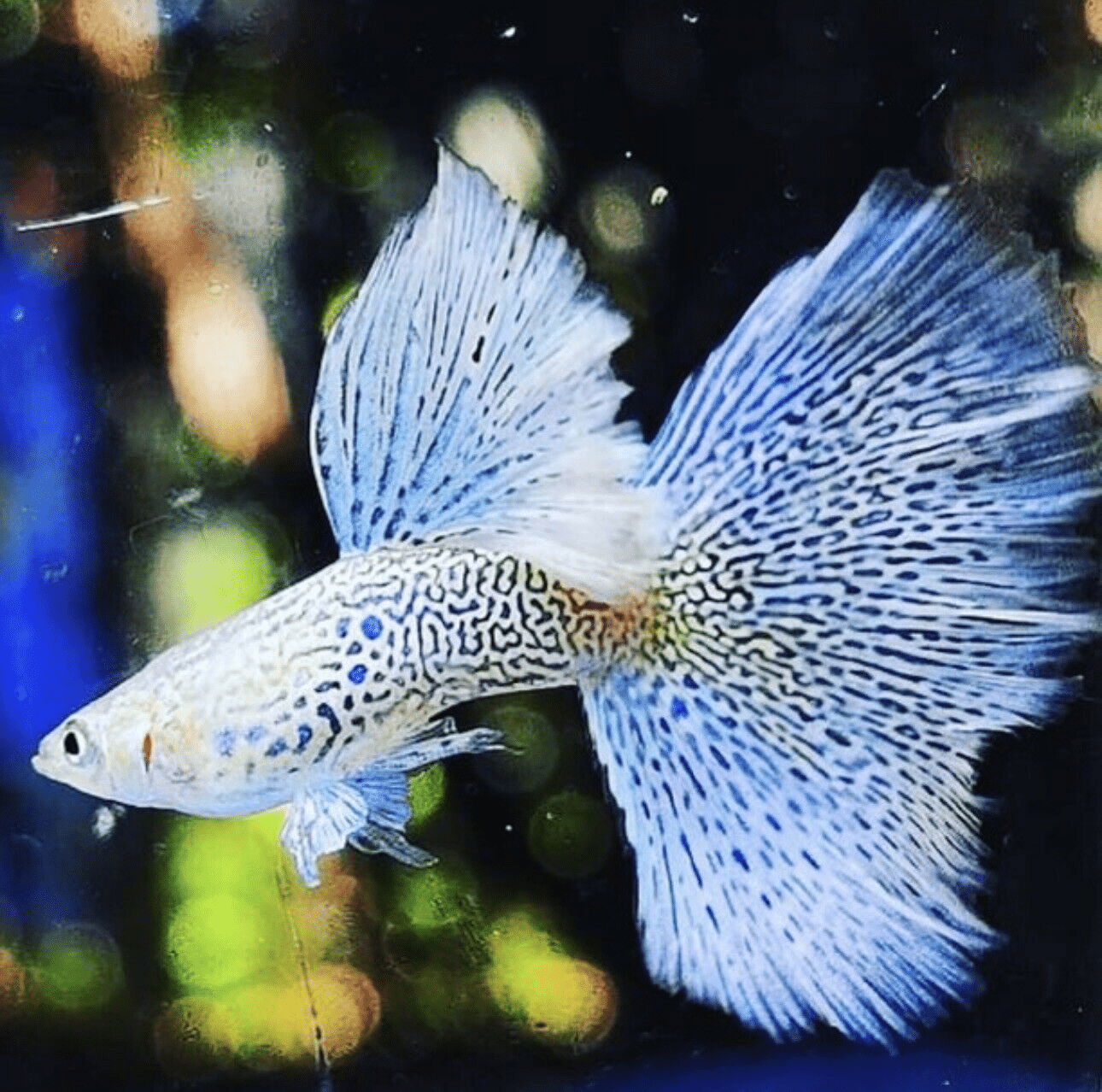

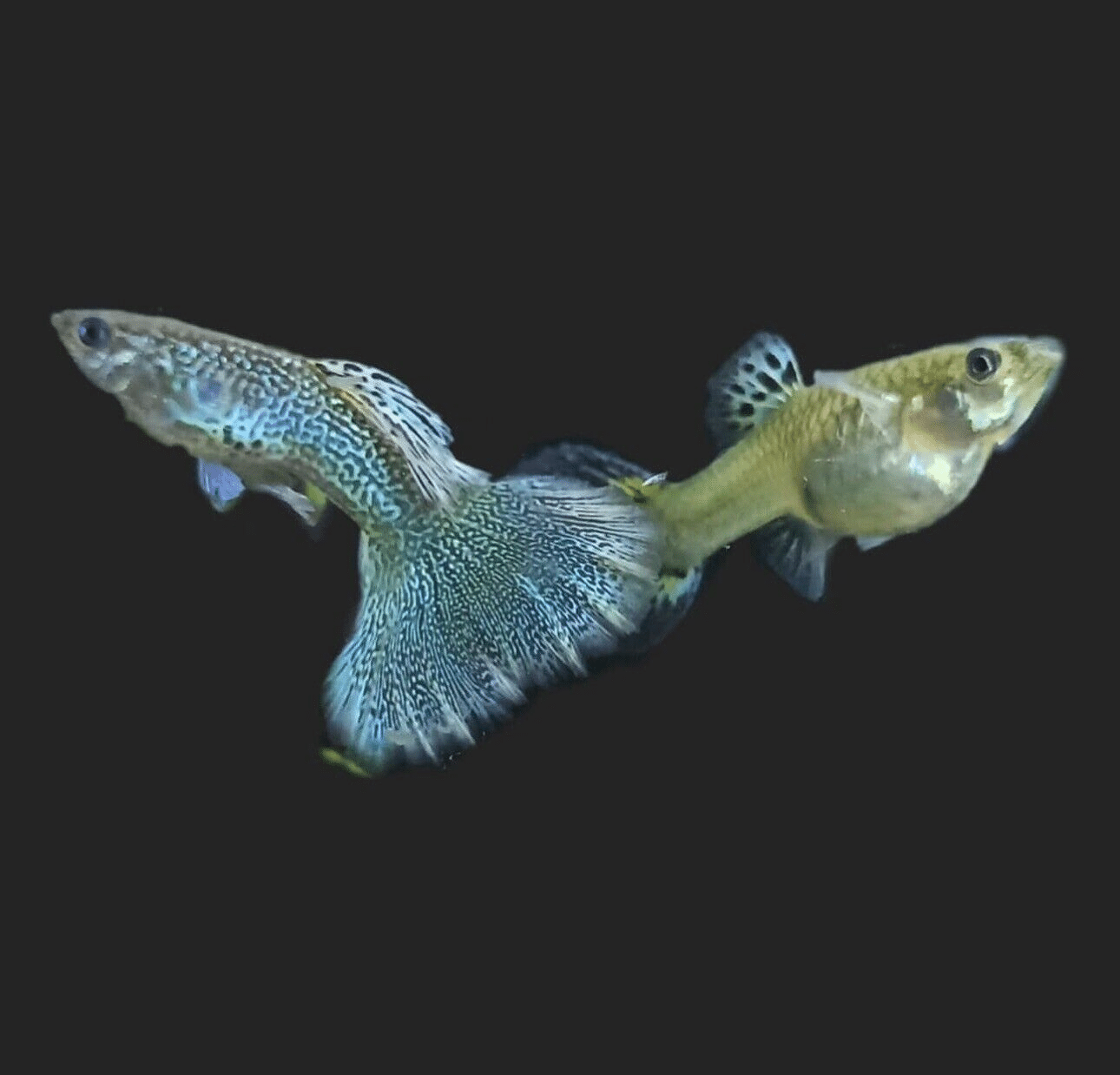
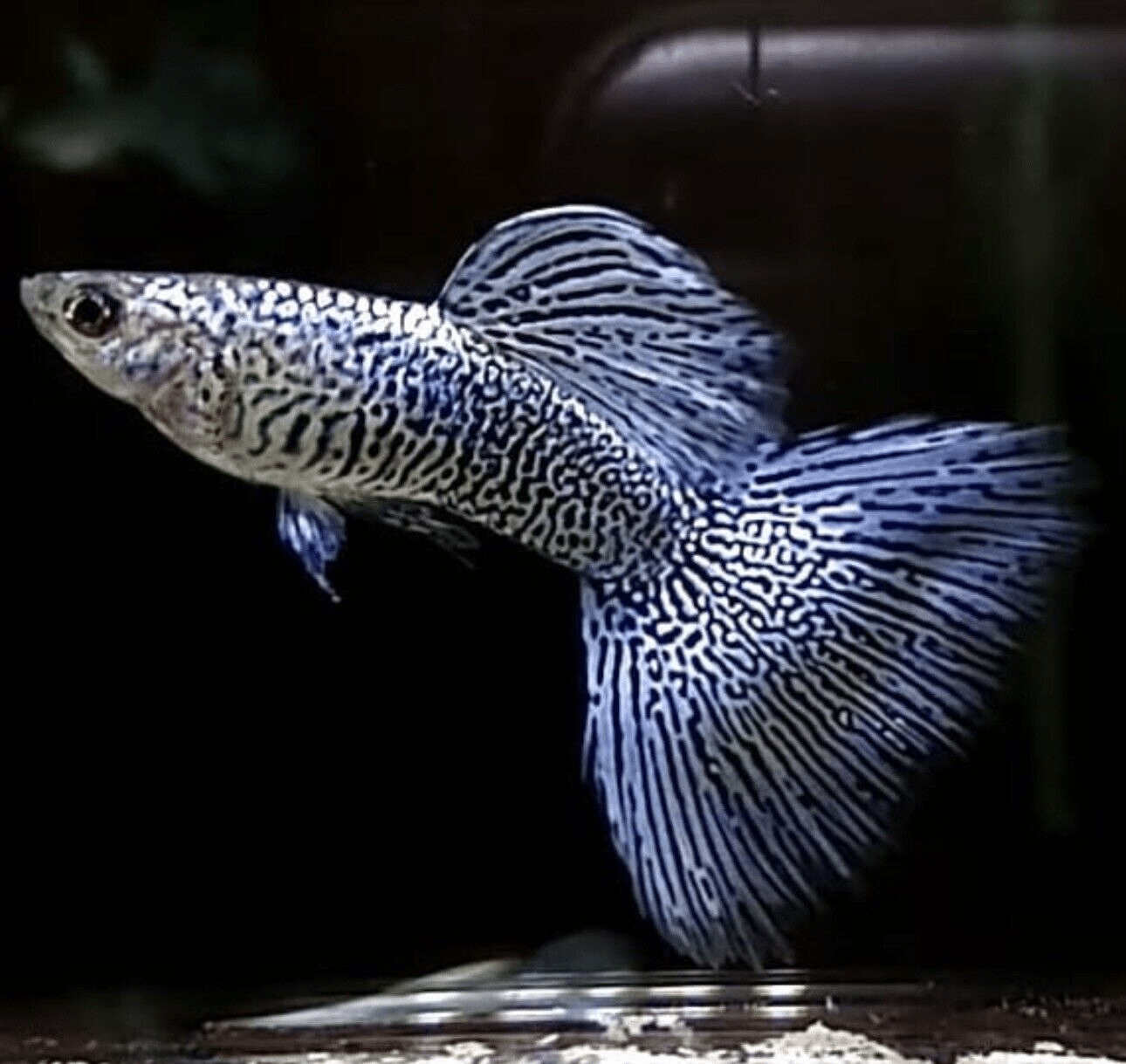
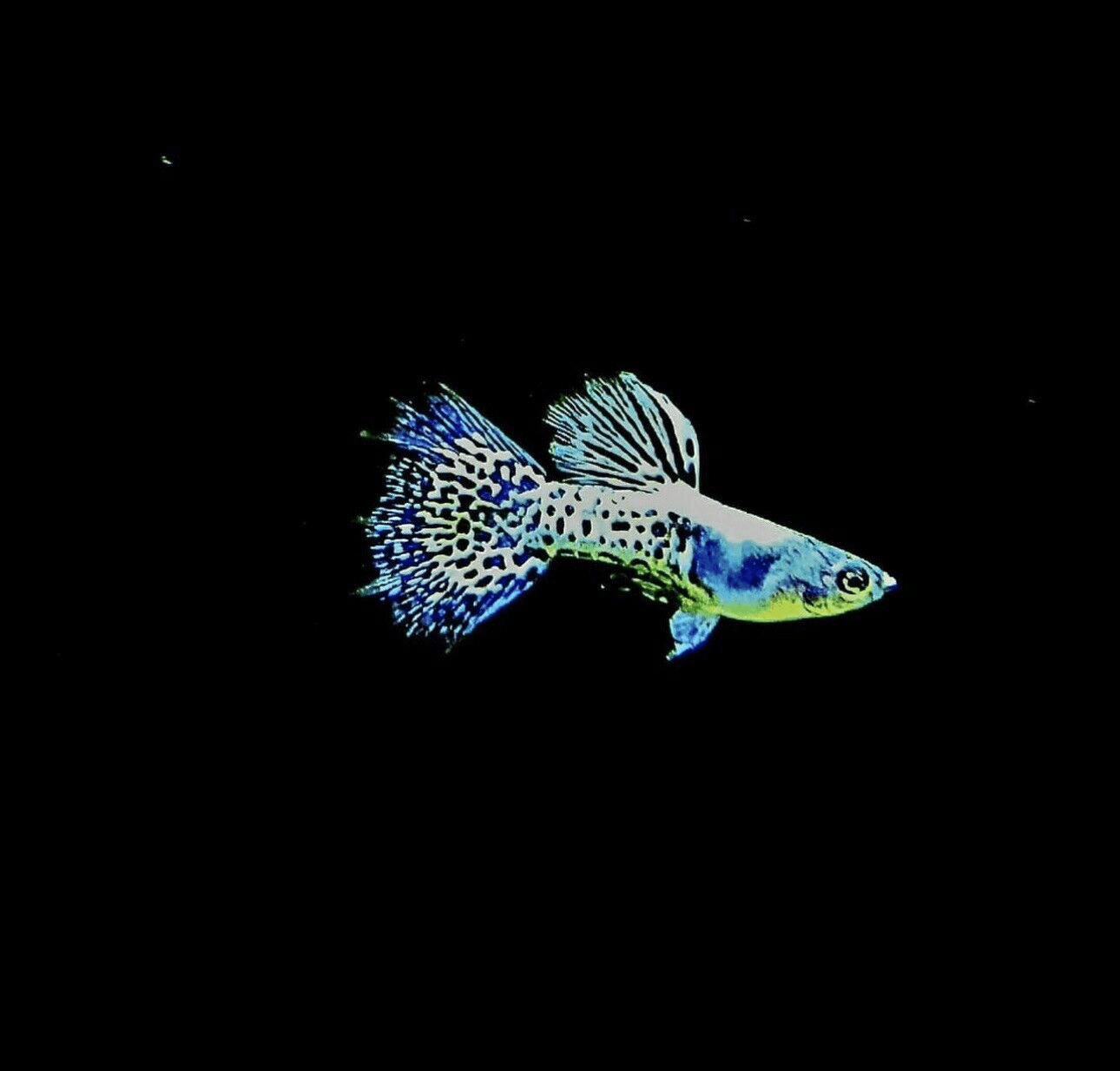

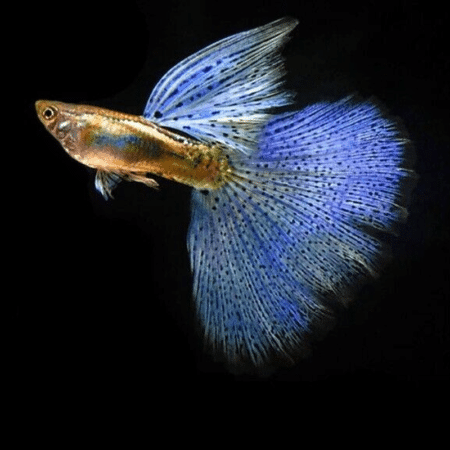
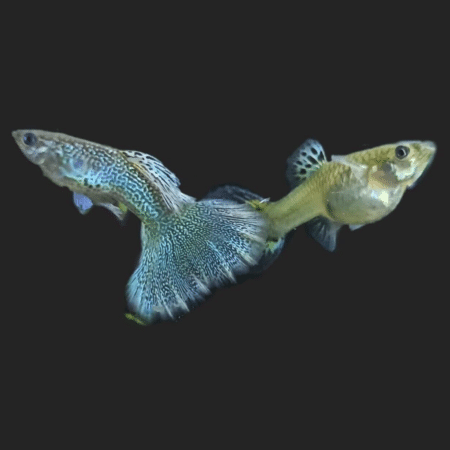
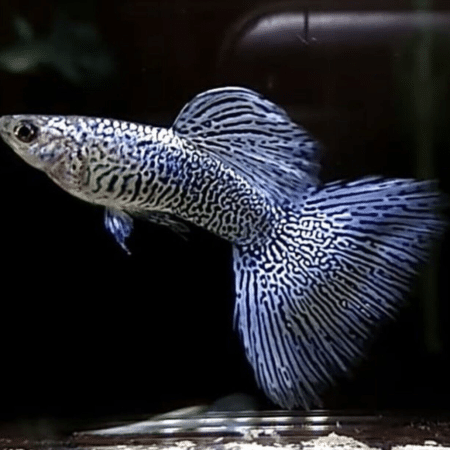
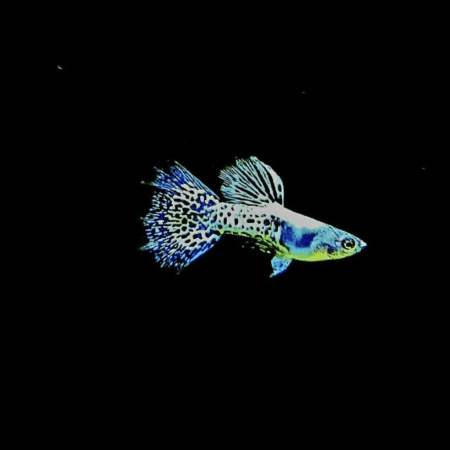
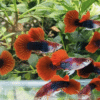
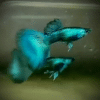








Emily Thompson (verified owner) –
I recently purchased a pair of Blue Lace Guppies (1 male and 1 female) and I couldn’t be happier! As a passionate aquarium hobbyist, I’ve kept a variety of fish, but these guppies are truly special. They arrived in superb condition after just a couple of days, and their vibrant blue lace patterns are mesmerizing!
After about two weeks in my tank, I noticed their personalities shining through—they’re very social and love to explore. I feed them high-quality fish food, and their colors seem to pop even more with a balanced diet.
I’ve kept guppies before, but the Blue Lace variety has a unique elegance that makes them stand out. They’re ideal for community tanks and are perfect for beginners and seasoned fish enthusiasts alike. One minor concern is that they tend to breed easily, so be prepared for some little fry!
Overall, I highly recommend these beautiful guppies to anyone looking to add some charm to their aquarium. They truly bring joy and life into my tank! Plus, with a lifespan of around 2-3 years, they make for delightful companions in your aquatic journey.
Emily Martinez (verified owner) –
I recently purchased a pair of Blue Lace Guppies (one male and one female) for my 20-gallon freshwater tank, and I couldn’t be happier! After just two weeks, they’ve settled in beautifully and added such vibrant color to my aquarium. The male’s intricate lace patterns are breathtaking, and it’s a joy to watch them swim together. I appreciate the care guides included in the packaging; they provided excellent tips on guppy breeding and nutrition that helped me ensure they’re thriving. In comparison to previous guppy pairs I’ve owned, these guys are definitely higher quality and more active. They seem to be happier and more sociable, which makes me feel good as a caring fish parent. The only minor concern is that they can be a bit shy during feeding time, so I recommend adding some floating plants to help them feel more secure. If you’re looking to add some lively companions to your aquarium, I can’t recommend these Blue Lace Guppies enough! Perfect for both beginners and experienced aquarists alike. Overall, a fantastic purchase!